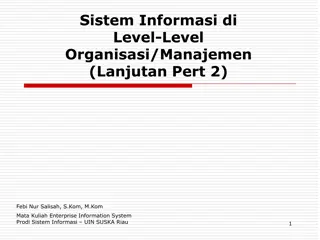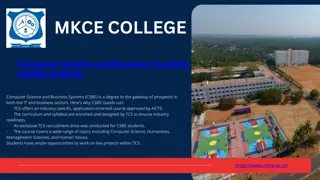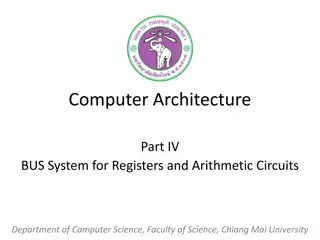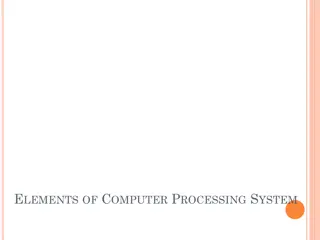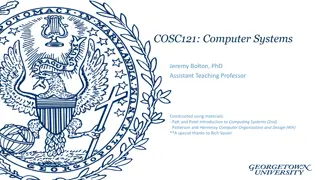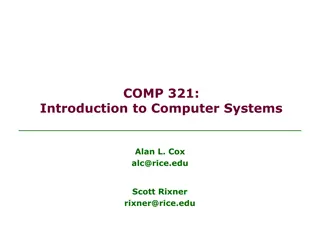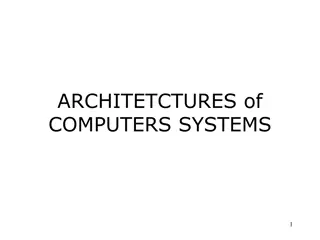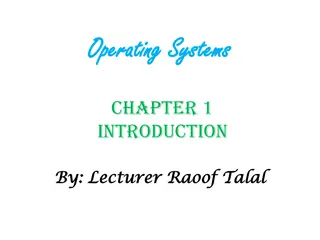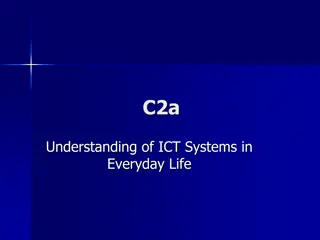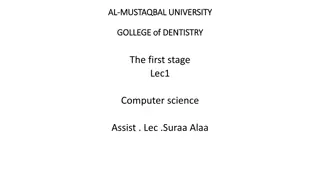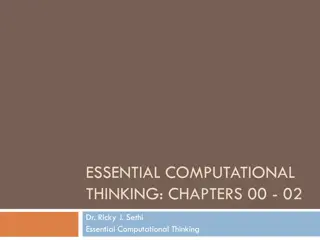Importance of Time in Computer Systems
Computer systems rely on accurate and stable timekeeping for various functions such as event scheduling, security certificates, and synchronization. Maintaining precise time is essential for ensuring proper system operations and data integrity. Challenges like temperature fluctuations and voltage changes can affect the stability of computer clocks, emphasizing the need for synchronization with reference time to keep systems running smoothly and securely.
Download Presentation

Please find below an Image/Link to download the presentation.
The content on the website is provided AS IS for your information and personal use only. It may not be sold, licensed, or shared on other websites without obtaining consent from the author.If you encounter any issues during the download, it is possible that the publisher has removed the file from their server.
You are allowed to download the files provided on this website for personal or commercial use, subject to the condition that they are used lawfully. All files are the property of their respective owners.
The content on the website is provided AS IS for your information and personal use only. It may not be sold, licensed, or shared on other websites without obtaining consent from the author.
E N D
Presentation Transcript
Whats the Time? Geoff Huston APNIC
Background All computers run with some kind of internal oscillator (mistakenly called a clock ) This clock manages the internal state changes each cycle of the central processing unit Clock ticks are fed to a digital counter From this counter the computer can maintain a conventional clock and maintain the current time
Why is Time useful? To stop everything happening at once!
Why is Time useful for a computer? To understand when things happen Crontab and event scheduling to ensure that a computer performs certain tasks at precise times To understand the relative age of things For example, with NFS file systems its vital to understand which file is more recent To understand when things are valid
Security Certificates and Time These security credentials are only usable in a defined window of time The computer s local clock is compared to these dates to determine whether to trust this certificate or not
So we need to keep time But this can be challenging Computer clocks are based on quartz Crystal oscillation Quartz crystal oscillation is only stable if the temperature and excitation voltage are kept stable. Changes in temperature or voltage will cause oscillation changes Computer time of day clocks rely on counting ticks in a register Which is performed by software running in the processor at an elevated interrupt level If the processor runs for extended times at an even higher interrupt level then clock ticks can be lost
So we need to keep time We actually want to keep accurate and stable time Accurate in that every reference timekeeper keeps the same time (modulo the spacetime stretch factors of relativity) Stable in that the duration of each measured interval is exactly the same We need to synchronize the internal computer clock to a reference time
What is reference time? We all know that time is divided into days, where a day is defined as the duration between successive events when the sun is at precisely the same elevation in the sky But we don t do this any more because the earth and the sun are poor timekeepers We turned to distant quasars as the reference point But we don t do this any more because we needed even greater precision We turned to nuclear physics Time is defined using Syst me International (SI) seconds, defined as the duration of 9,192,631,770 periods of the radiation emitted by a caesium-133 atom in the transition between the two hyperfine levels of its ground state at a temperature of 0K
Distributing Accurate Time Not every computer runs their own Cesium Clock or runs a GPS receiver to maintain accurate time But some folk do So what we would like is a way to take this set of highly accurate reference time sources and provide a mechanism for others to synchronize their local clock against a reference source On the Internet we use the Network Time Protocol (NTP) to perform this time synchronization function
NTP Operation Time sources are classified by their accuracy A Stratum 0 server is a reference clock (GPS or cesium) A Stratum 1 server is directly connected to a reference clock source A Stratum 2 server receives its time from a Stratum 1 server, and so on NTP is a simple clock exchange UDP protocol T2 1 client time T1 1 client time 1 client time 2 server time 1 client time 2 server time Server Client T3 T4 Client Offset = ((T2-T1) + (T3-T4))
NTP Operation In steady state the UDP clock packet exchange happens every 16 seconds Faster clock exchanges happen when the client clock has lost synchronisation with the server, and it will burst 8 packets evenly spaced across a 16 second interval If the local clock needs to be adjusted the client time application will use adjtime() to slew the local clock. Clock correction is slow 0.5ms per second Jumping the clock can fatally confuse applications, so this gentle slew is far kinder NTP can normally maintain a client clock within a few hundredths of second of the server reference clock
So we all agree on the time? If everything supports NTP, and there is a well structured mesh of NTP reference clock servers then every connected Internet device that runs a clock should have the same value of time same is within a tenth of a second or less But does the Internet agree on the time?
The Experiment Use a scripted online ad to direct a client report back on the time of day on the client system Use the Javascript getTime() method to get the local UTC clock value Pass this value to the server as an argument to a URL fetch operration Use NTP-managed clock on the server to maintain a stable reference clock Record the distribution of differences Ignore the fine-grained differences due to local processing and network propagation time Which means that we are looking at measurements of time within +/- 1 second as being equivalent
Results We tested the clock of 202,460,921 clients over a 80 day period: 11% of clocks are more than 1 second fast 57% of clients are more than 1 second slow We observed clock slew values of up to 1 year both fast and slow 92% of clients are within 120 seconds of the reference clock
A view of Whole of Internet Time Only 58% of visible clients run their clock with 2 seconds of UTC time 92% of visible clients run a clock that is within 60 seconds of UTC time 98% of clients are within 1 hour of UTC time
Fast Clocks 0.05% of all clocks are ahead by more than 2 days There is a clear step function in this distribution that is aligned quite precisely to whole days How can a client clock maintain a stable per-second clock, yet report a time value that is off by a number of whole days?
Fast Clocks 0.7% of all clocks are ahead by more than 1 hour As with the day distribution, there is a marked clustering of the clock offsets into units of hours, and a slightly smaller clustering into half- hours Similar question: How can a client clock maintain a stable per-second clock, yet report a time value that is off by a number of whole hours?
Slow Clocks 0.15% of all clocks lag by more than 2 days (3 x the number of fast clocks) The per-day clustering is not so clear for slow clocks with a lag of greater than 2 days.
Slow Clocks 1.05% of all clocks lag by 1 hour or more Here there is a marked clustering of the clock offsets into units of hours
Clustering of Clock Slew Values This is a distribution of the clock slew values when the whole hours are removed There is a very strong signal that when a clock has slewed from UTC time it does so in units of hours (and less so in units of half-hours) NTP does not stablilze a local clock into a slew value of a whole number of hours, so this distribution is not an artefact of NTP. What is going on here?
Clustering of Clock Slew Values This is a distribution of the clock slew values when the whole hours are removed There is a very strong signal that when a clock has slewed from UTC time it does so in units of hours (and less so in units of half-hours) NTP does not stablilze a local clock into a slew value of a whole number of hours, so this distribution is not an artefact of NTP. What is going on here?



